Troop 280 Straps on Snowshoes for a Mountain Adventure
A 3.8-mile hike doesn’t seem like much. You could probably walk one of those miles in less than a half hour.
But if you’re gaining more than 2,000 feet in elevation up a mountain and powering over snowy trails while pulling a sled full of gear, then it would take you a little longer.
It took Troop 280 of Parker, Colorado, nearly six hours to make such a demanding hike last winter. It was a challenge, but the Scouts didn’t give up. They had a destination: a spacious cabin overlooking the snow-capped Rocky Mountains.
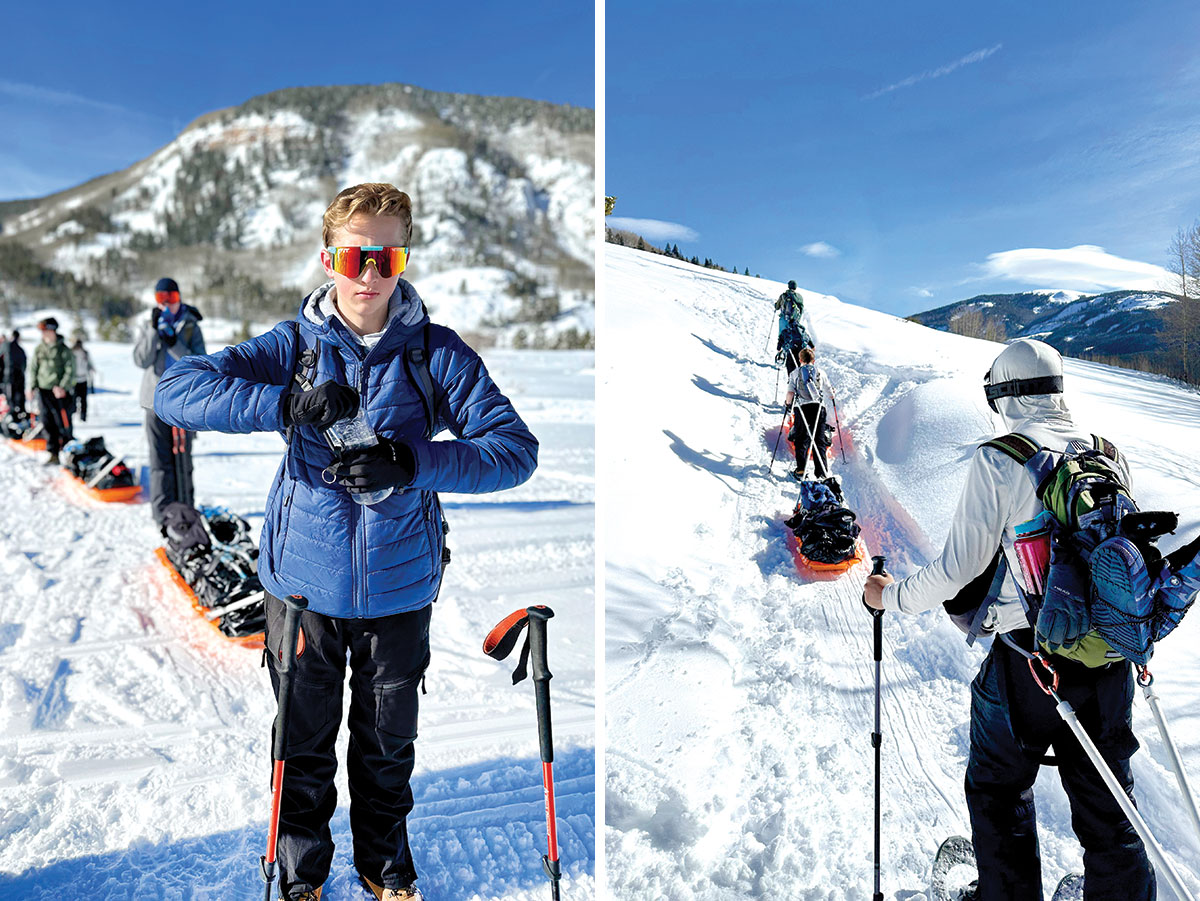
Right: The troop hikes to a large cabin operated by the 10th Mountain Division Hut Association. The association is named in honor of World War II Army soldiers who trained in the area before deploying to Italy. Left: Logan Nelson takes a water break. It’s important to stay hydrated, even in cold environments.
“The views were absolutely beautiful,” says Chance Sundermeyer, 16, a Life Scout. “Each window had a different kind of view. Then you go outside, and the sun was going down. It was incredible.”
Checking out the scenery from the cabin definitely was a plus, but so was the journey there as the troop tried this winter activity for the first time.
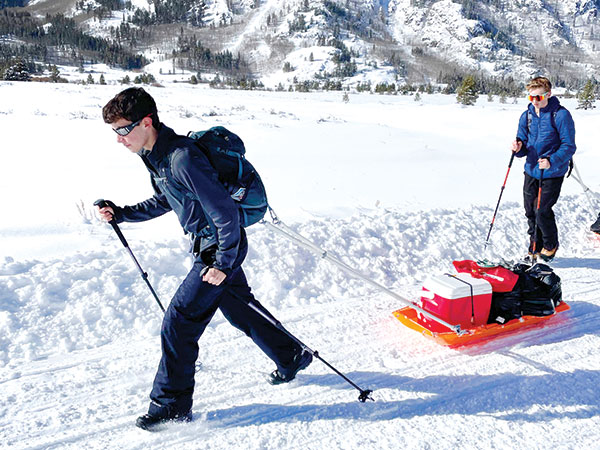
Bennett Wilson, followed by Logan Nelson, pull their gear on pulk sleds. The Scouts loved the adventure on this outing but agreed it was tough.
SLEDS AND SNOWSHOES
This campout required a lot of preparation, including booking the cabin a year ahead. It’s a popular place, situated on the side of a mountain near Leadville, Colo., offering spectacular views while sleeping up to 16 on bunks.
With the cabin booked, the troop had to figure out its next challenge: getting there. When you’re walking in snow, your feet can easily sink into the slush, slowing you down and quickly draining your energy. To combat this, you need to spread out your weight. Wearing snowshoes helps you do this.
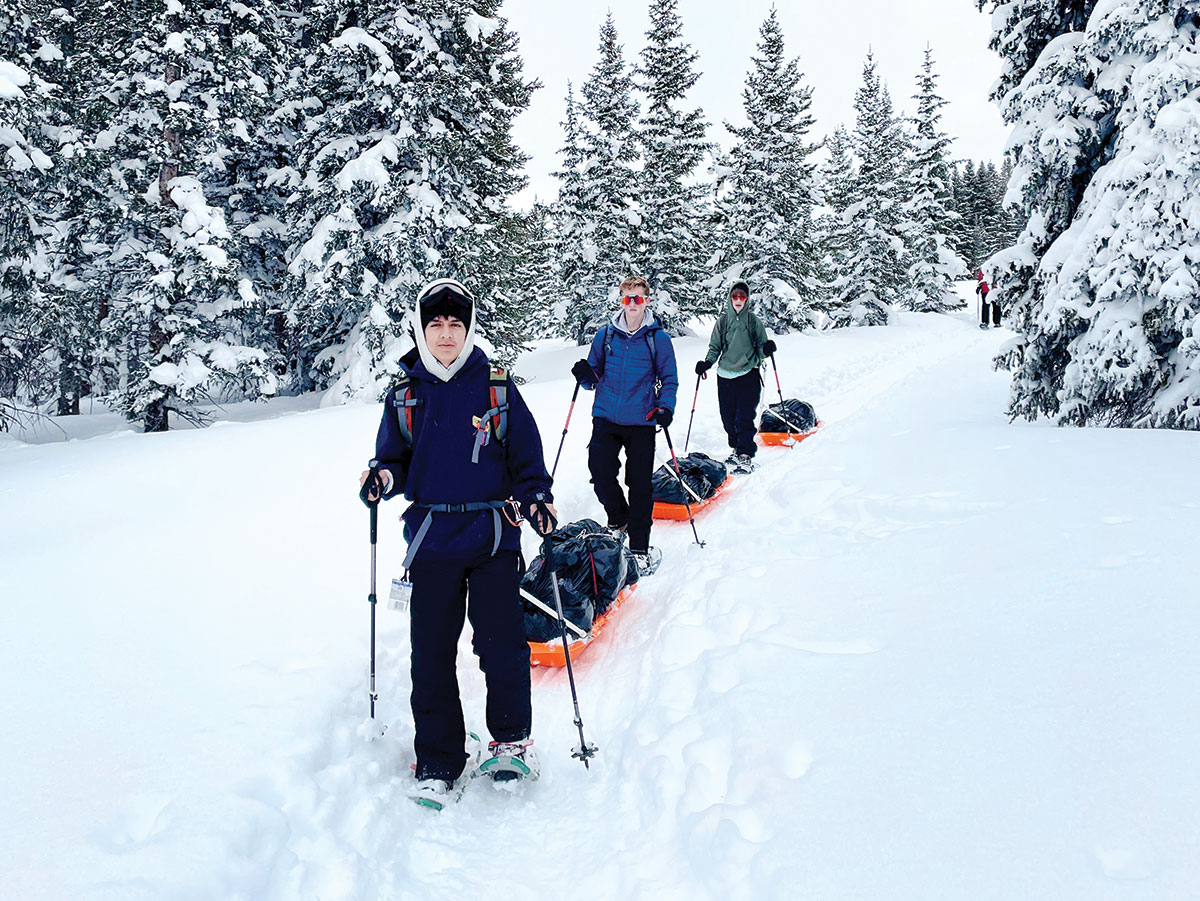
From left, Vinny Guzman, Logan Nelson and Kyle Garwood of Troop 280 pull their pulk sleds through Colorado’s White River National Forest.
Historians believe snowshoes were invented about 6,000 years ago. They were made with a piece of wood and some binding to attach to the feet. This simple design let the wearer walk on top of the snow, making travel much easier. The design hasn’t changed much over the millennia, though the materials and features have — like lightweight aluminum frames and sharp crampons to add traction. For their trip, Troop 280 rented snowshoes.
“We tried one type of snowshoe,” says Eagle Scout Corwyn Brown, 16. “They had a metal frame and a rubberized canvas material and a mount for your boots.”
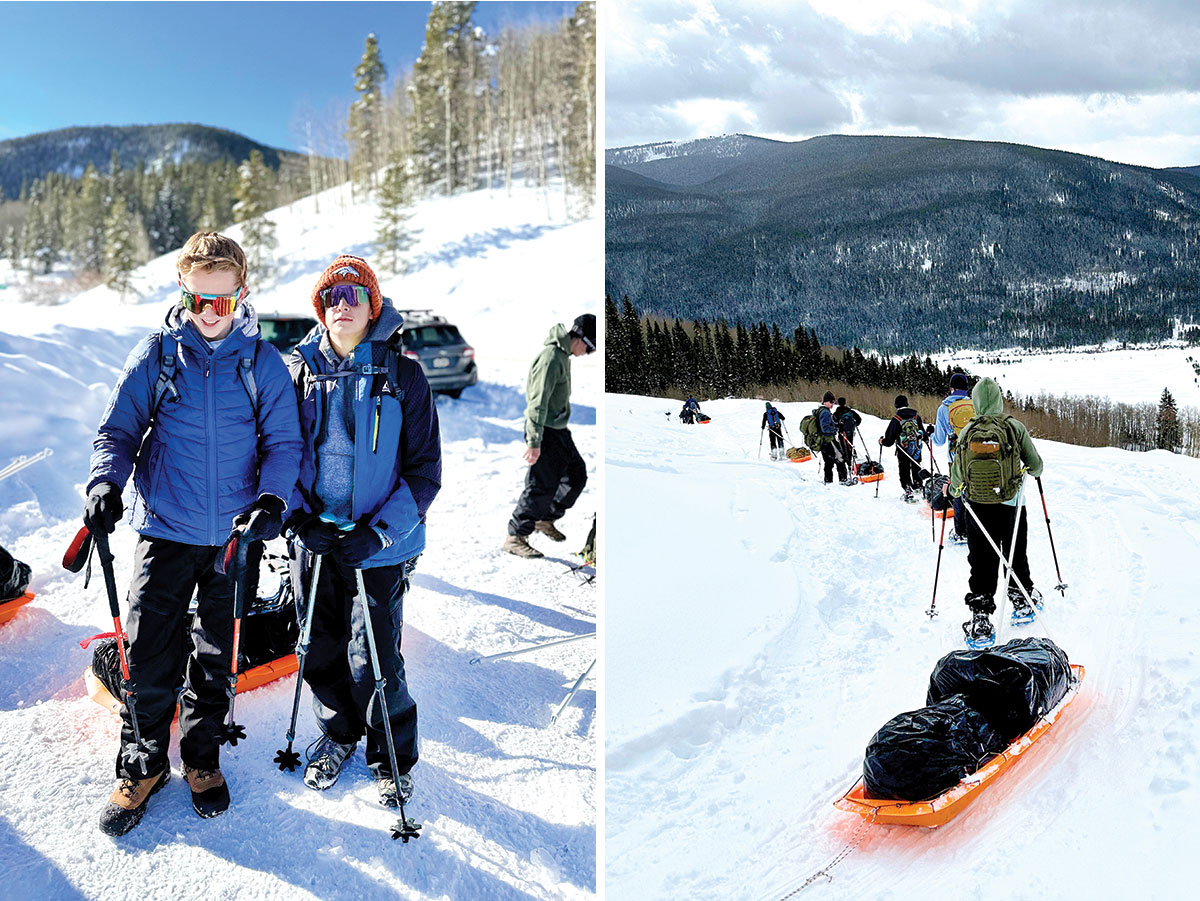
Right: The trail was covered in several feet of snow. Snowshoes keep you from sinking into the snow. Left: Logan Nelson, left, and Chance Sundermeyer both used trekking poles equipped with snow baskets to help them hike.
They could have carried all their stuff, but the Scouts opted to use another winter device: pulk sleds. This is a sled you drag behind you, designed to comfortably and efficiently transport your gear. Before the outing, the Scouts spent a day building their sleds and testing them out. Each sled took four hours to complete.
“The design was based off one my dad found online,” Corwyn says. The base for each sled was purchased at REI, and the paracord, PVC pipe, epoxy and bolts were found at Home Depot.
“We did some experimenting with making the brackets.” Corwyn adds. “That was the only thing we had to fabricate ourselves.”
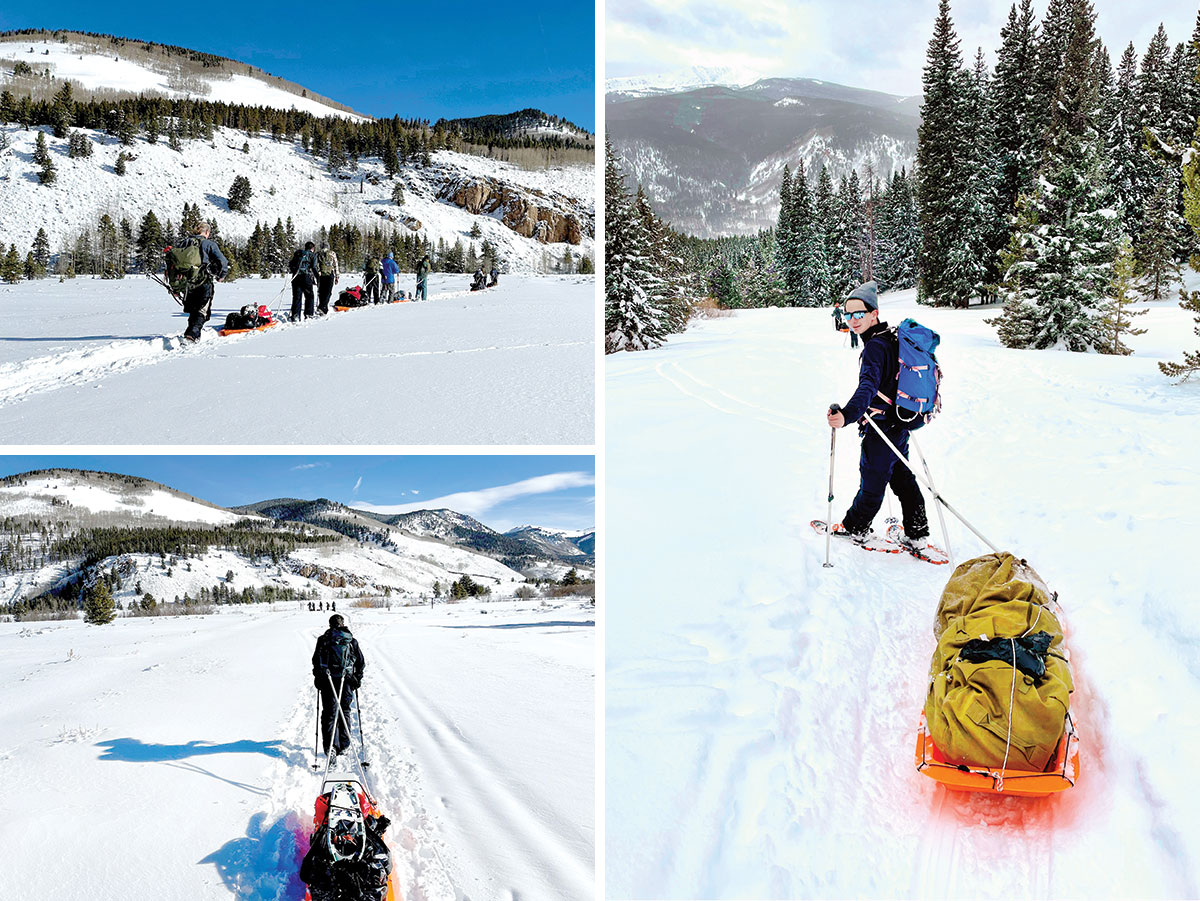
Right: Corwyn Brown, an Eagle Scout with Troop 280, pulls his pulk sled while snowshoeing in Colorado. Bottom left: The Scouts built and tested their pulk sleds before using them on the trail. Make sure you do the same before going on a hike as well as prepare physically to go. Top left: The troop hikes across the snow near the start of the trailhead.
SLOW GOING
With their gear secured to their sleds and snowshoes on their boots, the Scouts set off from a parking lot in Colorado’s White River National Forest.
“For about half a mile, it was just flat,” says Bennett Wilson, 17, a Life Scout. “Then we hit the trailhead, and it was straight uphill.”
It helped that other hikers had made a trail in the snow, but even with that and the winter equipment, the hike soon became difficult.
“The climb was very hard,” Bennett says. “It was probably one of the hardest campouts I’ve been on. We had to take lots of breaks. We had to deal with blisters forming. It was a lot.”
When tackling a sharp climb, it’s a good idea to pace yourself, hydrate and use trekking poles since they can provide stability as you ascend.
“We’d stop every five to 10 minutes; it was very steep,” says Star Scout Kyle Garwood, 14. “Every fifth stop, we’d drink some water and adjust our sleds.”
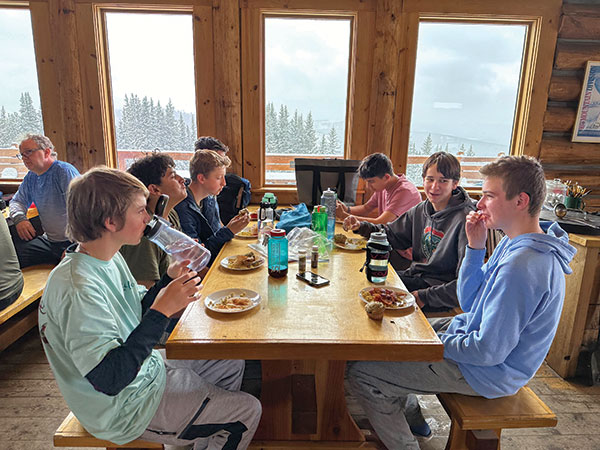
The Scouts enjoy a warm breakfast in the cabin.
A LOFTY GOAL
The Scouts were rewarded with stunning views once they made it to the cabin. They took in the sights while setting up for the night: rolling out sleeping bags on the bunks, firing up the wood-burning stove and cooking a fajita dinner. After eating, reading and playing a few card games, the Scouts were ready for bed.
“You didn’t have to be in your sleeping bag, necessarily,” Corwyn says. “It was a nice and comfortable temperature in there.”
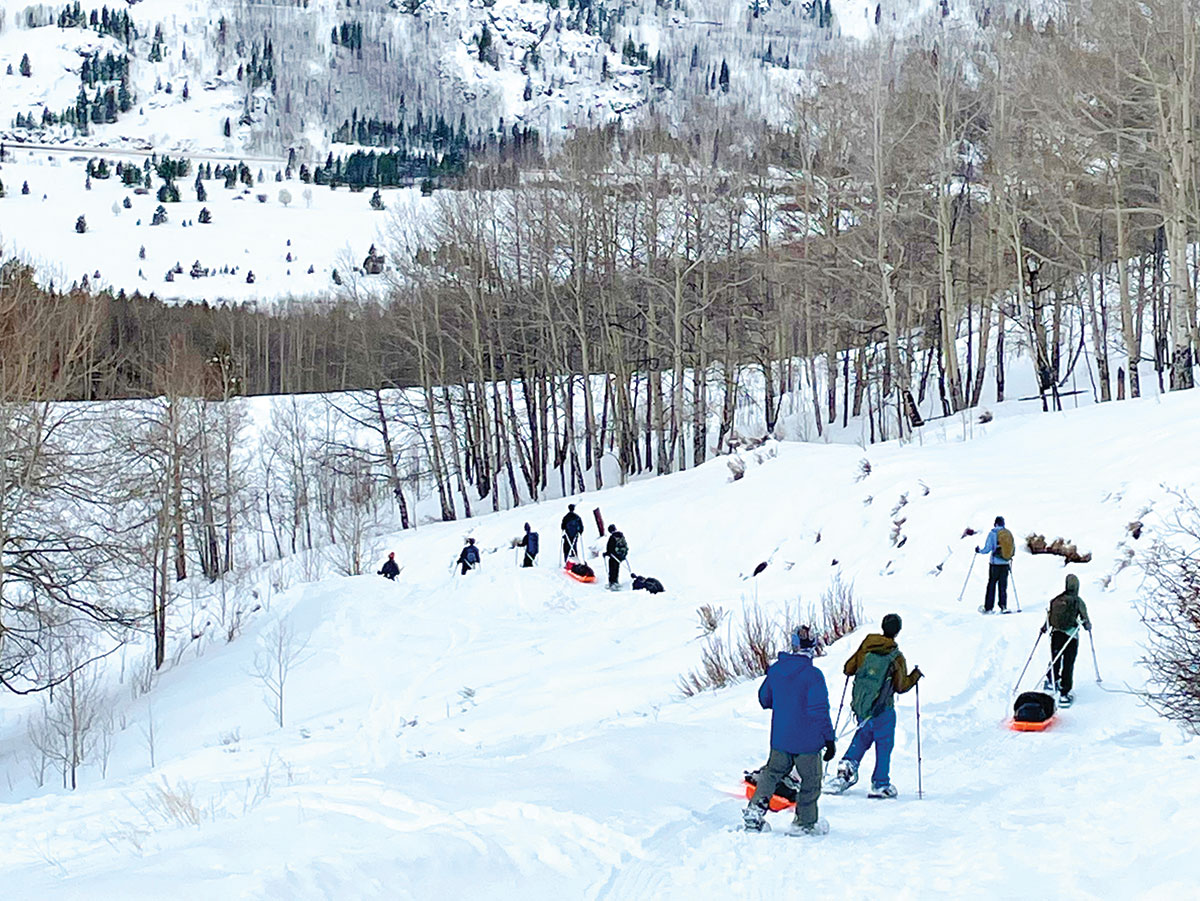
Scouts head back down the mountain after spending the night at the cabin.
Hiking down the mountain the next morning was a lot easier. Instead of a six-hour trek, it took only two. Still, it was important for the group to take their time and use their trekking poles to avoid slipping and falling.
Despite the difficulty, the troop enjoyed the winter hike. They overcame challenges and got to spend time with each other.
“It was the hardest hike I’ve ever done, but it was my favorite I’d ever done,” says Fischer Wilson, 14, a Life Scout.
Selecting Snowshoes
Snowshoes come in different styles, each designed for different trails. For flat terrain, a simple snowshoe works well. These tend to be more affordable because they don’t have as many features.
For more grueling treks, look for snowshoes that come with sturdier binding systems, better crampons and the option to lift your heel. These features all help on a steep hike.
Smaller snowshoes are also easier to use on steeper trails, while larger models are better for traveling across powdery snow.
Make sure your equipment fits properly and is designed to handle your weight before your trip.
Leave a Comment